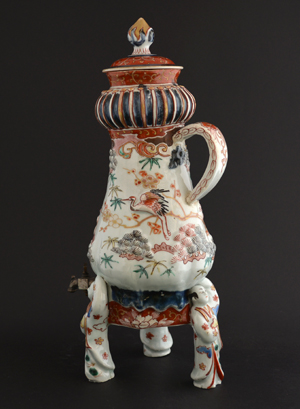
ARITA c.1690 – 1730 Japanese Porcelain
A Japanese Porcelain Coffee Urn, Arita Kilns c.1690-1730. Modelled After a Dutch Silver Proto-Type but the Subjects Depicted are Mostly in the Japanese Style. The Large Complicated Moulded Form is Supported by Three Female Figures. The Moulded Body is Also Enamelled, it Depicts a Red-crowned Crane Arriving at it`s Nest in a Pine Tree to Feed it`s Young.
SOLD
- Condition
- There are several large firing cracks to the interior, these show through to the exterior in places. Some might be stress cracks, there are cracks to the supporting figures that might or might not be firing cracks. There is a large fitting crack to the handle. The on / off attachment is not the original but I thing the metal spout is.
- Size
- Height : 39 cm (15 1/4 inches)
- Provenance
- N/A
- Stock number
- 24421
Information
Japanese Imari Porcelain :
Imari Porcelain is the European collectors` name for a type of Japanese Porcelain made in the town of Arita, in the former Hizen Province, north western Kyūshū, and exported via the port of Imari, specifically for the European Export trade. Imari was simply the trans-shipment port for Arita wares, no porcelain was made there. The kilns at Arita formed the heart of the Japanese Porcelain industry, which developed in the early 17th century. Although Imari originating in Japan the tern is used to describe a whole range of ceramics from all over the world, they are all linked by their bright distinctive palette of blue, red and gold. The cobalt that created the blue was added prior to glazing, while the iron-oxide red and the gilding were applied after glazing.
Red-Crowned Crane :
The Red-crowned Crane, Grus Japonensis, also called the Japanese Crane or Manchurian Crane, is a large crane and is now the second rarest crane in the world. The estimated population of the species is only 1,500 in the wild. Red-crowned Cranes breed in large wetlands in temperate East Asia and winter along rivers and in coastal and freshwater marshes in Japan, China, and the Korean Peninsula. In Japan, this crane is known as the Tancho.
References :
For an Arita coffee-urn of this form and design but with a different finial and colour scheme, dated to c.1690-1710, see : China for the West, Chinese Porcelain & other Decorative Arts for Export Illustrated from the Mottahedeh Collection (David S. Howard and John Ayers, Sotheby`s,1978) Volume 1 page 128, number 108. As with all publications by David Howard there are some very useful notes and comparisons, plate 108a shows a silver coffee-urn of this general type and date described as `probably Flemish or Dutch colonial (Sotheby`s, 20 February 1976, lot 97). He continues "But although generally considered to be for coffee, such urns may also have been used sometimes for tea. A painted table-top of c.1700 shows Nicolaas Heinius and his family apparently taking tea from a metal urn of basically the same form".
For another Arita coffee urn of this form, dated to c.1700, see : The Choice of the Private Trader, The Private Market in Chinese Export Porcelain illustrated from the Hodroff Collection (David S.Howard, Zwemmer,1994. ISBN 0 302 00642 7) page 141 plate 141.







